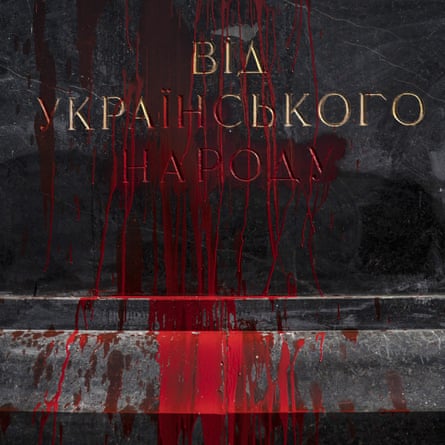The country’s ultranationalist groups came to the fore in 2014, when they kickstarted massive street protests that led to the ousting of the Russia-friendly president Viktor Yanukovych. Russia responded by annexing Ukraine’s Crimean peninsula and backing separatists in the east, moves that drew sanctions from the west. Thousands of Ukrainian nationalists then headed to the east, forming volunteer battalions that served as a vanguard for the Ukrainian forces in the rebel regions.

Nationalists take part in a martial arts training session in Kiev

Children with rifles attend a summer camp organised by the nationalist Svoboda party in a village near Ternopil
Since then, the influence of nationalist groups has steadily grown, driven by public dismay over the country’s economic woes and rampant corruption. Mostly teenage members of the ultra-right groups have followed the guidance of war veterans, practising martial arts and learning how to handle weapons. The number of ultranationalists is estimated at about 10,000, and they can quickly take thousands to the streets and resort to violence.

Members of Sokil, the youth wing of the nationalist Svoboda party, dance during a concert in Kiev

Members of a far-right group, some wearing balaclavas, march towards a Russian orthodox church in Kiev
“They have undergone organisational, military and ideological training,” said Andriy Yermolayev, the head of the New Ukraine independent thinktank. “They are strongly motivated and active.” Torch-bearing ultra-right activists regularly march to the beat of drums across the Ukrainian capital’s downtown, chanting, “Death to traitors of Ukraine!” During one scuffle at the memorial to a Red Army general killed in the second world war, an elderly woman approached a group of radical nationalists shouting, “Hang the Russians!” and defied them, saying: “I’m Russian, hang me!” One of the rightwingers, Kiryl Nedin, pushed her back and was briefly detained for resisting police.

Nationalists rally to mark the birthday of Stepan Bandera, the founder of a rebel army that fought against the Soviet regime, in Kiev

A vandalized portrait of the late Ukrainian Marxist and feminist poet Lesya Ukrainka in central Kiev
In a series of violent actions that underline their strength, rightwing radicals in recent years have assaulted gatherings by LGBT and women’s rights activists, attacked Roma encampments around the country, derailed a lecture on the history of the Holocaust and brawled with pro-Russia veterans. The ultra-right groups also have a strict, military-style structure, and many of their members have battlefield experience from years of fighting in the east.



Nationalists rally to mark Defender of Ukraine Day in Kiev
Yermolayev said in the past the government turned a blind eye to the rise of nationalist groups, using them as a scare tactic, but now the ultra-right has turned on the authorities. “The well-organised and aggressive nationalism in Ukraine is a child of the government. It has lost control over radical nationalists. [Petro] Poroshenko has lost that game.”

A former soldier and member of the National Corps party warms himself next to a bonfire near Kiev

Members the youth wing of the nationalist Svoboda party stand in formation after a concert in Kiev

Soldiers wait with military vehicles before a rehearsal for the Independence Day military parade in Kiev
International human rights groups have strongly criticised the Ukrainian government for failing to track down and punish those responsible for the acts of violence and intimidation. The government has promised to rein in the ultranationalists, but has taken no action. The interior minister, Arsen Avakov, said the rightwing organisations will be stopped. “They all know it very well,” he said. “And ... there will be no amnesty for them.”

Dusk in Kiev
Miroslav Mareš, an expert on rightwing extremist groups at Brno University, said Ukraine’s far right has been successful in reaching out to ultranationalist forces in Europe.
“They have good relations to some neo-Nazi groupings in central and eastern Europe,” Mareš said. He added that early in the conflict in eastern Ukraine, some members of Europe’s neo-Nazi groups trained and fought with the Azov battalion, a Ukrainian ultra-right paramilitary group that advocated white supremacist views.

Nationalists fight with pro-Russian supporters at the Soviet-era monument to Gen Nikolai Vatutin in Kiev

Nationalists get changed after a martial arts training session in Kiev
The Ukrainian far right also appears to have ties in other countries. The Australian Brenton Tarrant, accused of slaughtering 50 people at two mosques in the city of Christchurch in New Zealand, mentioned a visit to Ukraine in his manifesto, and some reports alleged he had contacts with the ultra-right.

Paint thrown by nationalists drips from the Soviet-era monument to Nikolai Vatutin, a Red Army general who died during the second world war, in Kiev

A member of the National Corps party near Kiev
Yermolayev, the political analyst, noted that a violent image projected by Ukrainian nationalists could serve as an argument for those in the European Union who are reluctant about putting Ukraine on a membership track any time soon. “How can you integrate a country plagued not only by corruption but also nationalism?” he said.
